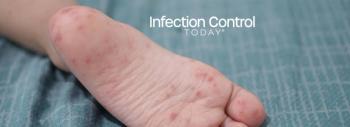
- Infection Control Today, May/June 2025 (Vol. 29 No.3)
- Volume 29
- Issue 3
A Helping Hand: Innovative Approaches to Expanding Hand Hygiene Programs in Acute Care Settings
Who knew candy, UV lights, and a college kid in scrubs could double hand hygiene adherence? A Pennsylvania hospital’s creative shake-up of its infection prevention program shows that sometimes it takes more than soap to get hands clean—and keep them that way.
Hand hygiene is the cornerstone of infection prevention in the hospital setting. Health care workers’ hands are recognized as vectors of harmful pathogens, yet adherence to hand hygiene protocols often falls short of expectations.1 Not only does hand hygiene performance serve as a metric that impacts local and national hospital rankings,2 but comprehensive hand hygiene monitoring programs are required for hospital compliance with Centers for Medicare & Medicaid Services standards.3 Despite public health, financial, and reputational incentives, capturing hand hygiene observations to assess and improve adherence remains an opportunity for hospitals.
Background
To address challenges with hand hygiene adherence and staff engagement, the infection prevention department of a 493-bed academic hospital sought to improve its hand hygiene program. From July 2023 through June 2024 (fiscal year [FY]23), 3 innovative approaches were implemented to increase hand hygiene observations, improve hand hygiene performance, and foster sustained engagement in the hospital’s hand hygiene program. These approaches included establishing a dedicated workforce to focus on hand hygiene at institutional and unit levels, providing hands-on training and education to multidisciplinary staff, and communicating directly with leadership regarding unit-level hand hygiene performance.
A Dedicated Workforce
Although all health care workers are responsible for performing hand hygiene, monitoring has historically been the responsibility of a facility’s infection prevention program. The scope of infection preventionists (IPs) spans far beyond the duties of hand hygiene monitoring, including infection surveillance and control, outbreak response, compliance with state and national reporting and regulatory requirements, maintaining environment of care, granting construction permits, and more. With a national median of 1 IP per 121 acute care patient beds,4 dedicating certified IPs to operate a robust hand hygiene program may not always be practical.
To address this need, the department’s administrative coordinator was assigned to prioritize and spearhead the growth of the hand hygiene monitoring program. The coordinator became the administrator of the facility’s electronic hand hygiene monitoring platform designed to capture moments of hand hygiene when entering or exiting a patient’s room. The coordinator ensured staff in clinical and nonclinical areas had access to the platform and completed training on the mobile-based monitoring application. Users were educated on accurately discerning between performed and missed hand hygiene opportunities.
To bolster the number of observations across the hospital, the infection prevention department onboarded an undergraduate student volunteer. An IP and the coordinator trained the volunteer to ensure they understood infection prevention principles, including hand hygiene and the electronic monitoring system. The volunteer was granted a security-issued identification badge and access to hospital-laundered scrub attire to enable observations to be conducted throughout the facility.
To maximize efficiency, the volunteer was dispatched to units and departments with low observation rates and to areas with exceptionally high performance rates to validate the data. The volunteer’s general anonymity also offered a way to discount the Hawthorne effect of exemplifying better hand hygiene practices while being monitored.
Hands-On Training With Frontline Staff
Before these interventions, the hand hygiene program relied on clinical nurses as observers and hand hygiene champions for their units. However, given that a nurse’s primary responsibility is direct patient care, submitting hand hygiene observations on their cell phones was not always practical in their workflow. To increase observations across all inpatient units, nursing leadership officially appointed (by job description) unit clerks to complete a minimum number of hand hygiene observations per shift. To ensure success, the coordinator partnered with the nursing education department to educate unit clerks on recognizing and electronically documenting hand hygiene observations.
Additionally, the coordinator provided education on observation and data collection to clinical support roles such as pharmacists, dietary aides, and environmental service personnel who travel throughout the hospital and see a wider range of employees. As a result of these strategic interventions, the coordinator saw a 100% increase in active, trained observers using the application (Figure 1).
For direct engagement with clinical staff, the coordinator created a hand hygiene cart to conduct live education sessions during rounds on clinical units.
The cart was equipped with a UV light and UV lotion (a proxy for alcohol-based hand sanitizer) to effectively demonstrate how well the staff applied the product. During these traveling direct observation education sessions, the coordinator provided pamphlets to staff to reinforce proper hand hygiene practices. Those who participated received incentivizing samples of candy and hand sanitizer.
In addition to the overall improvement in hand hygiene performance (Figure 2), direct engagement with clinical staff was also achieved, which built a greater rapport between departments and served as a fun reminder to always wash your hands.
Engagement With Hospital Leadership
Although efforts to engage with frontline staff had always been in place, clinical and nonclinical leaders were largely unaware of their department’s hand hygiene performance. To improve transparency and promote leader engagement, the coordinator began sharing with leaders a weekly report of their department’s total number of observations and compliance rate by job role to highlight areas of opportunity. This direct and transparent communication was instrumental in securing support from leadership at all levels for engagement with the hand hygiene program. The interventions implemented in FY23 increased the number of active, trained observers performing hand hygiene observations.
Next Steps
During this period of sustained program growth, many observations were collected. This enabled the coordinator and IP team to focus educational efforts tailored to specific roles often documented as nonadherent in hand hygiene.
Lending a Hand to Other Hospital Hand Hygiene Programs
Innovative approaches to hand hygiene programs can help increase hand hygiene observations and improve performance in the hospital setting. Even without an automatic or electronic monitoring program, collecting observations and tracking adherence can benefit from expanding a hand hygiene workforce beyond the infection prevention team. This expansion fosters interactive learning and transparent communication with leaders. Although led by infection prevention departments, hand hygiene programs are further strengthened and sustained by innovation and multidisciplinary engagement in improving patient safety.
References
- Glowicz JB, Landon E, Sickbert-Bennett EE, et al. SHEA/IDSA/APIC Practice Recommendation: Strategies to prevent healthcare-associated infections through hand hygiene: 2022 Update. Infection Control & Hospital Epidemiology. 2023;44(3):355-376. doi:10.1017/ice.2022.304
- Handwashing. Hospital and Surgery Center Ratings | Leapfrog Group. (n.d.). https://ratings.leapfroggroup.org/measure/hospital/2024/handwashing
- The Joint Commission. https://www.jointcommission.org/standards/standard-faqs/home-care/national-patient-safety-goals-npsg/000002354/. Accessed 13 March 2025
- Bartles R, Reese S, Gumbar A. Closing the gap on infection prevention staffing recommendations: Results from the beta version of the APIC staffing calculator, American Journal of Infection Control. 2024; 52(12): 1345-1350. doi.org:10.1016/j.ajic.2024.09.004.
Articles in this issue
Newsletter
Stay prepared and protected with Infection Control Today's newsletter, delivering essential updates, best practices, and expert insights for infection preventionists.






